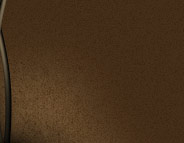|
File No.:

Title: "Word War Two
Submachine gun used by Jedburgh team
member"
Investigation made at: The
Netherlands
Period Covered: MAY1943 -
01FEB2024
Date: 18AN2024
GPS Location: N/A
Case Classification:
Description of a World War Two US
9mm UD M.'42 submachine gun most
likely used by a "Jedburgh" team
member during Operation "Market
Garden" in September 1944.
Case Status: Case Closed |
(click to enlarge)
.jpg)
Machine gun stock
with name of previous owner |
REASON FOR INVESTIGATION:
On 18JAN2024 this agency made use of
the opportunity to behold, handle,
examine, and document a rare
American United Defense Supply
Corporation 9mm UD M.'42 submachine
gun (SMG) manufactured and used in
World War Two. Evidence points to
the original user as being SSGT
Willard "Bud" Beynon, an Office of
Strategic Services (OSS) radio
operator and member of Jedburgh team
"CLARENCE" deployed during Operation
"Market Garden" in SEP1944. It will
be described as Battle Relic #34
below. |
SYNOPSIS:
United Defense UD M.'42
submachine gun
The UD M.'42 is a weapon
manufactured by the Marlin Firearms
company for the United Defense
Supply Corporation. The UD M.'42 was
designed and patented by Carl
Swebilius, founder of the High
Standard Firearms company, who in
turn had the Marlin Firearms company
produce the SMG for the UDS company.
It was designed/developed in 1940
but was not produced until 1942,
hence the later model number of "UD
M.'42". The UD M.'42 was originally
intended as a substitute for the
Thompson SMG, but by the time they
got into production, the
Thompson/Auto-Ordnance company
caught up with their back orders and
the intended orders for the UD M.'42
never materialized in any sizeable
quantity. It is estimated that total
production was approximately 15,000.
The weapon functions in a blow-back
type operation that uses a 20 round
Thompson SMG magazine. The UD M.'42
proved to be robust and reliable,
weighing only 9 lbs. empty, a pound
lighter than a Thompson and much
simpler to maintain. Lively in the
hands and well-balanced, it pointed
naturally, more like a rifle than an
SMG. Accurate in single shots, the
UD M.'42 was also very controllable
in full-automatic fire, despite a
cyclic rate approaching 1,000 rounds
per minute. U.S. infantry doctrine
considered such a high rate to be
excessive, but it was prized by some
expert users disciplined to fire in
short bursts. |
|
(click to enlarge)
_small.jpg)
_small.jpg)
_small.jpg)
Design diagrams for the UD M.'42
self-loading repeating gun,
filed on 15OCT1944 and patented in
1944 |
UD M.'42 Serial No.'s 8854/9192
The current owner is a collector and
is known to this agency but wishes
to remain anonymous. He resides in
the Netherlands and is licensed to
own historical firearms for
collecting purposes. In fact, he
even has two UD M'’42's in his
collection. The other gun has been
deactivated, like the one we will
describe here as Battle Relic #34
but has a lot more features of the
weapon welded shut, such as the bolt
and the double magazines.
The owner purchased this UD M.'42
several years ago and it was already
deactivated by that time. He stated,
without revealing too much about
previous ownership, that the entity
who sold the gun to him, originally
had acquired the weapon in working
order. It had to be deactivated due
to Dutch laws concerning possession
of historical firearms in a
collection. There is no provenance
as to how the gun ended up with the
seller, but the owner has a working
hypothesis about it.
As can be seen in the image below,
one significant feature of this UD
M.'42 is the name "BEYNON" carved in
the left face of the stock.
|
|
(click to enlarge)
.JPG)
.jpg)
.jpg)
“BEYNON”
carved in the wooden stock of the
gun |
Beynon
Beynon is the name of a US Army
Master Sergeant, Army Serial #
13151112, who served in the
Office of Strategic Services as a
radio operator of a "Jedburgh" team
that was deployed in the Netherlands
during Operation "Market Garden" in
September 1944.
Willard "Bud" Beynon was born on
2JUN1923 in SCRANTON, Pennsylvania.
He was a 1940 graduate of Scranton
Technical High School, a graduate of
King's College and the Pennsylvania
State Police Academy. He received
three Bronze Stars with Oak Leaf
Clusters among other decorations.
He was presented the Bronze Oak Leaf
and British Campaign Star by the
British government and the Dutch
Resistance Cross by Prince Bernhard
of the Netherlands. |
(click to enlarge)
Willard "Bud" Beynon
at far left without helmet and some
of his OSS buddies. Beynon was a non
smoker and the cigar and the
cigarettes in the other men's mouths
were handed to them by the
photographer just for the picture. |
Personnel dossier
The
OSS Personnel File of Beynon, Willard W M/Sgt
(file
# 54
230/86/27/03- RG 226 ENTRY
224 12/23/2010)
in the National Archives in
Washington D.C. have been restricted
until 2010. This agency asked for
the help of Joe of
Absolutely Archives to get
access to the file and on 31JAN2024
we received a scan of al fifty plus
pages in the folder.
The scanned documents reveal that
Willard Beynon weighed 155 lbs at a
height of 5' 9". He was raised by
his stepmother and finished high
school in Scranton, Pennsylvania
prior to joining the US Army. In
school he had learned the trade of
tool grinder and had one year of
Spanish language lessons.
During OSS training Beynon stood
out, but not always as an exemplary
soldier, as this anecdote shows: |
|
(click to enlarge)
 |
On 30JAN1945 it was reported that
Beynon "Wants to get into combat
agai.n Hopes to join his friends of
the Jedburgh teams in the Far East.
Buoyantly heedless of danger, this
young soldier contentedly accepts
whatever lot befalls him, so long as
it is a role of action. War morale
very high. His greatest wish is to
get into combat, although when he
jumped into Holland with the
American Airborne troops to aid in
organizing the Dutch underground, he
was constantly in danger, and the
other members of his team were
seriously wounded. Though raised by
a step-mother who doted him, he
shows little evidence of bad effects
from this upbringing, and indeed has
high emotional stability. Good
practical intelligence. Superior
social relations; if he were older
he will make a good leader."
|
On 10DEC1945 Beynon was interviewed
for his separation from the Army. He
had then served for 28 months of
which 21 overseas.
After Beynon had returned to
civilian life, he was awarded for a
Bronze Star Medal.
CAPT Arie Bestebreurtje recommended
Beynon for this decoration as
follows: |
|
(click to enlarge)
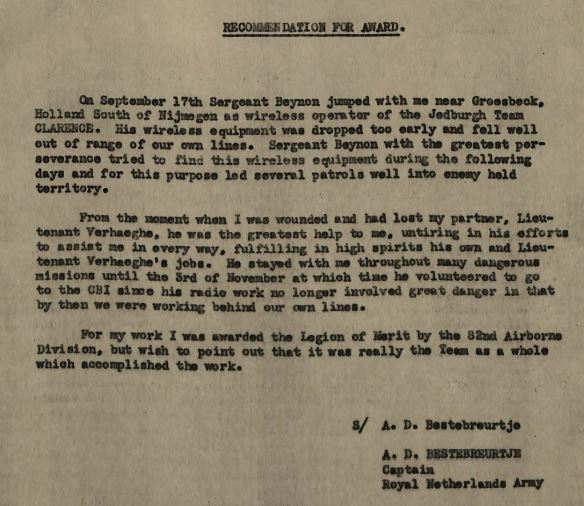 |
The file, unfortunately, does not
contain any references to the type
of weapons Willard Beynon was
trained on. Several documents
however bear Beynon's signatures but
as his name is scratched in the UD
M.'42 in capital letters.
A handwriting analysis therefore
does not render the inconclusive
evidence that Benyon wrote his name
in wood: |
|
.jpg) |
Provenance and previous ownership
From the book "Operatie Jedburgh;
geheime geallieerde missies in
Nederland 1944-1945" of
2014 by Jelle
Hooiveld of the Netherlands
Institute of Military History (ISBN
9789089532565) we know that a man
named Theo Smiet, a local resistance
fighter from the Nijmegen area, was
assigned to Beynon as a guide. After
Operation "Market Garden" Beynon
went on leave in LONDON for a few
days to report to Special Forces
Headquarters on the operation.
It is the owner's hypothesis that
Beynon for some reason, prior to his
trip to England, handed over
the UD M.'42 to Theo Smiet who
in turn kept it. |
(click to enlarge)

Theo Smiet,
resistance fighter from the Nijmegen
area and Beynon's local guide |
|
(click to enlarge)
.jpg) .jpg)
.jpg) .jpg)
United Defense
Sypllies Corporation M 42 submachine
gun w/serial no.'s 8854 and 9192
from four angles |
Stacked magazines
Moreover, the owner bought the gun
initially, without the double
Thompson-like magazines. He then
acquired a regular 20 round .45
caliber stick-magazine for a
Thompson Submachine and inserted
that in the magazine well of the
gun. This agency is familiar with
the tight knit Dutch community of
World War Two- militaria collectors
and could relate to the story that
the owner went on to tell us. The
ownership of the UD M.'42 became
known among several collectors, and
it was at a Dutch military show
which we frequent as well, that the
owner was offered to purchase a
double magazine for 9mm ammunition
designed for the UD M.'42. The price
was very high but still too good to
pass on. The provenance of this
magazine could be traced back to a
well-known army surplus shop in
midtown NIJMEGEN. The surplus shop owner had
been sold the magazine from an
unknown seller, without recognizing
its historical significance. He then
sold it to the previous magazine
owner for a fraction of the price
who in turn made a profit off the
current owner.
|
|
(click to enlarge)
.jpg)
.jpg)
Double stacked and
single 9mm magazines for the UD
m.'42 submachine gun seen from both
sides.
On the right is a 20 round single
magazine for.45 ACP ammunition,
shown here for comparison.
.jpg)
Top: UD M.'42
magazine with manufacturer's
details.
Bottom: Auto Ordnance magazine for
Thompson Submachine gun. |
Serial numbers
Other features of this UD M.'42 are
two different serial numbers. On the
lower receiver, stamped left from
the trigger on the right side, is
the number 8854. Also on the lower
receiver, on its bottom side behind
the trigger, is the number 9192. On
the bottom side of the barrel
extension is also the number 9192.
At first, we thought this could be
attributed to the fact that all
parts of UD M.'42's are
interchangeable and that this gun
was reassembled from one or more of
these weapons. But in a recent
article in the Dutch SAM gun
magazine (issue number 216 of
DEC2018) we found that it is common
for UD M.'42's to have two different
numbers in the same three places. |
|
(click to enlarge)
_small.jpg) 1 1
_small.jpg) 2 2
_small.jpg) 3 3
Serial numbers:
1) 8854 lower receiver, left from the trigger,
2) 9192 lower receiver,
behind the trigger,
3)
9192 barrel
extension. |
Interchangeability of UD M.'42
parts
Nonetheless, interchangeability of
UD M.'42 parts can also be traced
back to the Netherlands. At first
the UD M.'42 was designed in .45 ACP
caliber with the intent to sell it
to the US government to replace the
Thompson SMG. The first potential
buyer however became the Dutch
government in exile who wanted to
purchase submachine guns for the
Koninklijk Nederlandsch-Indisch
Leger (KNIL; Royal Netherlands
Indonesian Army) fighting the
Japanese in Indonesia. This was in
JUN1940. The Netherlands in Europe
at that time were already occupied
by Nazi-Germany since MAY1940. The
Dutch wanted the UD M.'42 to be
chambered in 9mm gun and ordered the
parts to be interchangeable.
Interchangeability of gun parts had
been the standard since the 19th
century but at first United Defense
Supply Corporation hadn't thought of
this. The Dutch found this out from
the sample guns provided to them
prior to the sale. They made it a
deal requirement that all parts of
the weapon could be used on every UD
M.'42. After the occupation of
Indonesia by Japan, the Dutch no
longer had any use for the UD
M.'42's ordered. |
|
(click to enlarge)
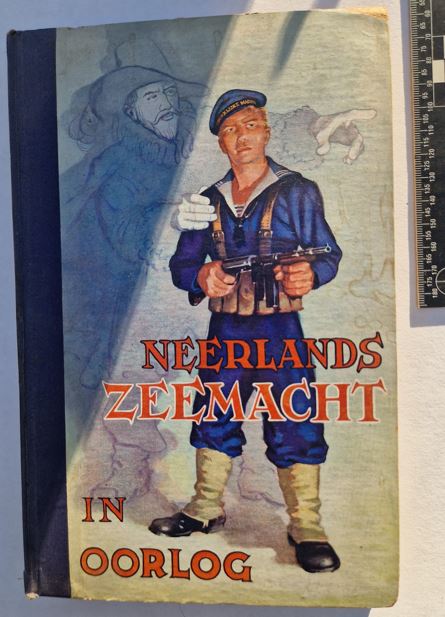
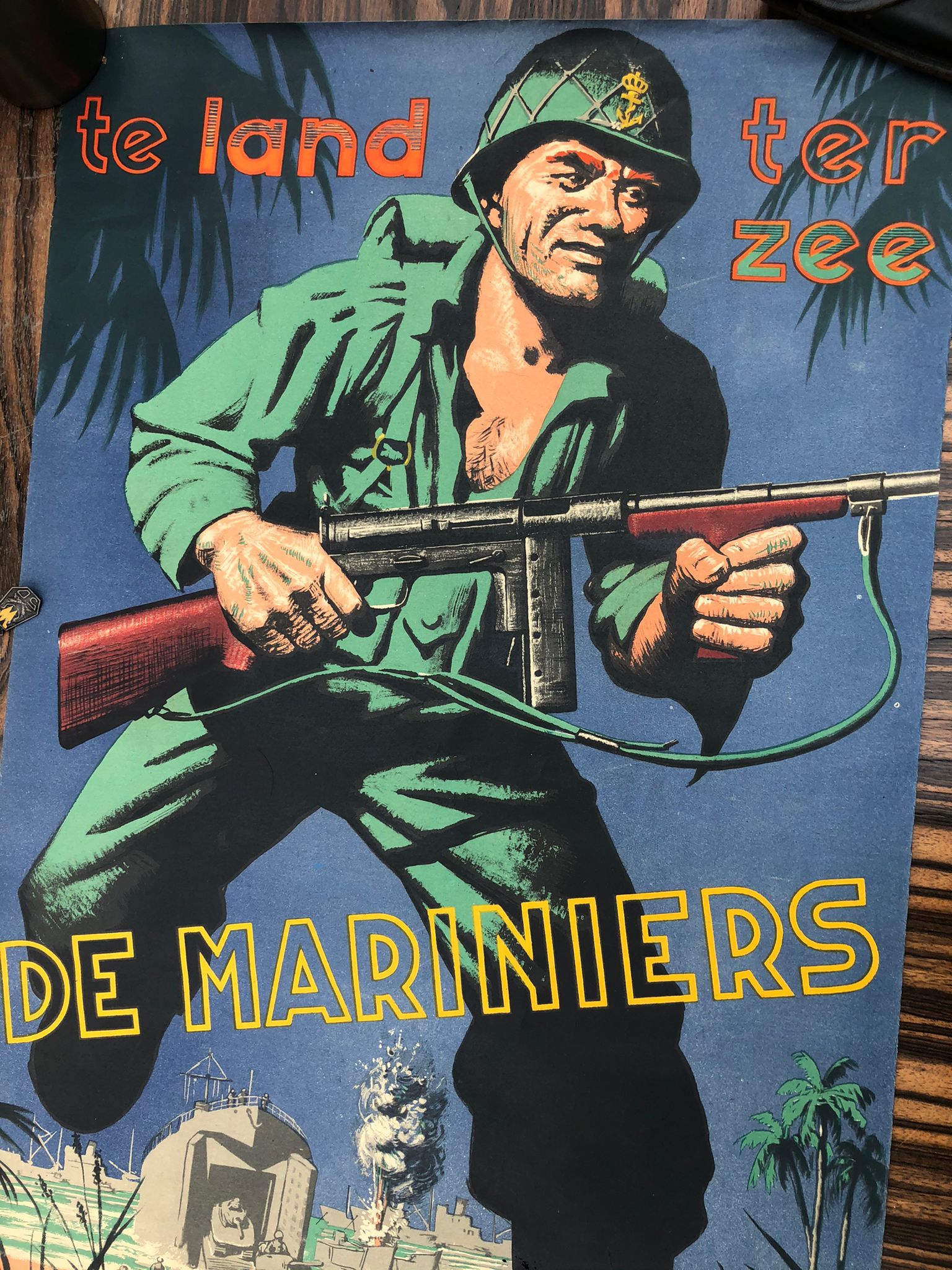
Although never
issued in full scale, the UD42
machinegun did well in Dutch
military advertising in 1944-'45:
Left: Cover
of a book titled "Netherlands Sea
Forces at War" by author A. Kroese,
published in London in 1944 .
Right: Recruitment poster for
the Dutch Marines "On land, at sea,
the Marines" 1945.
Both Dutch warriors are showed armed
with a UD M.'42 |
Procurement by OSS
The Dutch were however instrumental
in a subsequent deal to sell their
batch of guns, still in storage
stateside, to the Office of
Strategic Services. This US agency,
the forerunner of today's Central
Intelligence Agency (CIA), had an
urgent need for easy to operate
machine guns to be airdropped into
the hands of anti-Nazi resistance
groups in Europe. Also, the OSS
preferred the UD M.'42 to be
chambered in 9mm pistol ammunition
as this type of ordnance was
available in abundance in Europe
rather that the .45 caliber ammo.
US government records indicate that
2,405 9mm UD M.'42 SMGs were
air-dropped in France from JAN to
OCT1944 for use by OSS-related
resistance operations.
Source: "U.S.
Infantry Weapons of World War Two"
by Bruce N. Canfield, 1994, ISBN
0-917218-67-1
|
|
(click to enlarge)
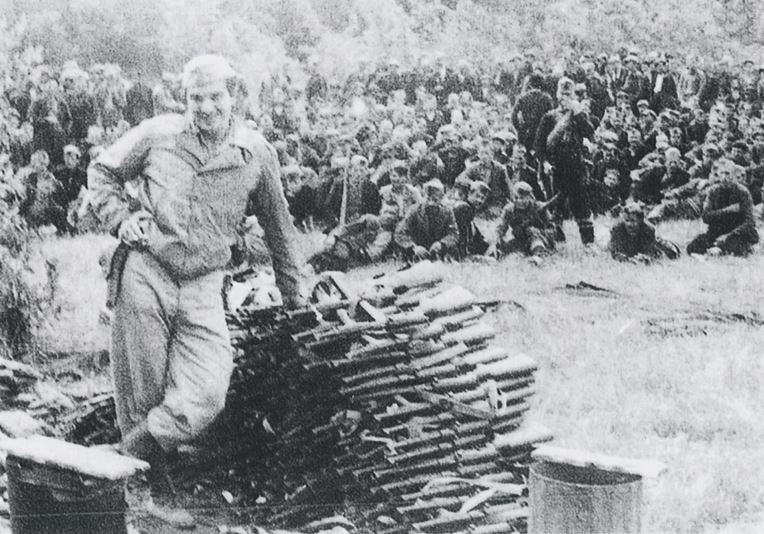
"Not so rare at
the time"
An member of the Office of Strategic
Services leans on a pile of UD
M.42's
about to be distributed to
resistance fighters in Southern
Europe. |
"Jedburgh"
These operations stemmed mostly from
Operation "Jedburgh", a clandestine
operation during World War II in
which three-man teams of operatives
of the OSS, the British Special
Operations Executive (SOE), the Free
French Bureau central de
renseignements et d'action and
the Dutch and Belgian armies in
exile were dropped by parachute into
occupied France, the Netherlands and
Belgium. The Jedburgh teams'
objective was to assist allied
forces who invaded Nazi-occupied
Europe on 6JUN1944 with sabotage and
guerrilla warfare, and leading local
resistance forces in actions against
the Germans. From SEP1944 to
APR1945, eight Jedburgh teams were
active in the Netherlands. The first
team, code named "DUDLEY" was
parachuted into the east of the
Netherlands one week before
Operation "Market Garden". The next
four teams were attached to the
Airborne forces that carried out
Operation "Market Garden". |
|
Jedburgh team "CLARENCE" in the
Netherlands
One of these teams was code named
"CLARENCE", landed near Groesbeek on
17SEP1944 during Operation "Market
Garden" and consisted of Dutch CPT
Arie Bestebreurtje and the American
1LT George Verhaeghe and SSGT
Willard Beynon. They landed in the
operations area of the 82nd Airborne
Division and performed several
tasks, including intelligence
gathering and liaison work between
82nd Division staff and local
resistance fighters in the NIJMEGEN
area. |
(click to enlarge)

Team "Clarence" from left to
right:
1LT George Verhaeghe, SSGT
Willard Beynon and CPT Arie
Bestebreurtje |
The 82nd Airborne Division
manifested SSGT Beynon separately
from his officers for the flight to
the Netherlands. CPT Bestebreurtje
and 1LT Verhaeghe accompanied
Brigadier General James M. Gavin,
the Commanding General of the
division, in the division’s lead
plane. Beynon was in Plane 3 with
the team's equipment and radios. The
C47s encountered heavy flak en
route. All members of team
"CLARENCE" jumped safely with the
508th Parachute Infantry Regiment,
but the team's equipment was lost.
Instead of repacking the three
equipment bundles and attaching them
to the wings of the plane so they
could be dropped simultaneously with
Beynon's stick, the IXth Troop
Carrier Command chose to drop the
equipment from the door before the
stick jumped. As a result, the
equipment landed in the REICHSWALD
forest in Germany. Beynon and
another paratrooper went off to the
forest in an attempt to recover the
equipment, but quickly met automatic
weapons fire and returned.
Team "CLARENCE" was very successful
in vetting and organizing members of
the resistance. Within one hour
after their drop, CPT Bestebreurtje
had contacted the leader of the
80-man GROESBEEK resistance movement
and assigned some of these
individuals to the division's
regiments as guides and
interpreters. The GROESBEEK
resistance leader found CPT
Bestebreurtje a telephone and
provided him the special code which
enabled him to talk to underground
leaders in NIJMEGEN and ARNHEM. The
resistance in ARNHEM informed him
that the British had landed safely
and that all seemed to be going
according to plan. He relayed this
news to General Gavin. ON 20SEP1944
a platoon of U.S. paratroopers
averted SSGT Beynon from driving
into a minefield. Beynon, who was en
route to corps HQ, temporarily
joined this platoon. While Beynon
was with them, the platoon repelled
two German crossing attempts along
the canal at MOOK. Communications
improved for team "CLARENCE" from
22SEP1944 until the end of their
mission. SSGT Beynon borrowed team "EDWARD"'s
B-2 set to request another radio
from Special Forces Headquarters (SFHQ).
Although SFHQ never supplied a W/T
set, "CLARENCE" retained "EDWARD"'S
set when the headquarters mission
exfiltrated on 27SEP1944. Sergeant
Beynon remained in LONDON for
approximately 48 hours, and returned
to Holland on 3OCT1944 with CPT
Peter Vickery, a British Jedburgh
who replaced the wounded 1LT George
Verhaeghe. CPT Bestebreurtje, who
had remained in country and was now
receiving orders directly from
Prince Bernhard's HQ, linked up with
these men in the ARNHEM-NIJMEGEN
area to form team "STANLEY II".
"STANLEY II"'s mission differed
greatly from "CLARENCE"'s earlier
mission to organize underground and
local populace support for the 82nd
Airborne Division. SFHQ, in
coordination with Prince Bernhard's
HQ, directed "CLARENCE" to train
resistance groups into functional
military organizations that could
perform conventional missions when
operating with Allied forces. Beynon
later deployed with a Jedburgh team
to the China-Burma-India-theater.
Willard "Bud" Beynon and George
Verhaeghe both survived the war.
Source: “The Role
of Jedburgh Teams in Operation
Market Garden” by MAJ Robert G.
Gutjahr, Fort Leavenworth, Kansas,
USA, 1JUN1990
Online: https://apps.dtic.mil/sti/tr/pdf/ADB149933.pdf
retrieved 20JAN2024
|
Stoottroepen
In order to "train resistance
groups into functional military
organizations that could perform
conventional missions when operating
with Allied forces" Dutch
volunteers from liberated areas were
added to newly formed
Stoottroepen (storm troops). To
this day the Regiment
Stoottroepen Prins Bernhard
is an integral part of the 11th Air
Mobile Brigade of the Royal
Netherlands Army.
CPT
Bestebreurtje and SSGT Beynon
established several Stoottroepen
training centers by the end of
NOV1944. They were assisted by Dutch
instructors SGT R. Westerling and
SGT G.H.J. Bendien.
|
|
(click to enlarge)
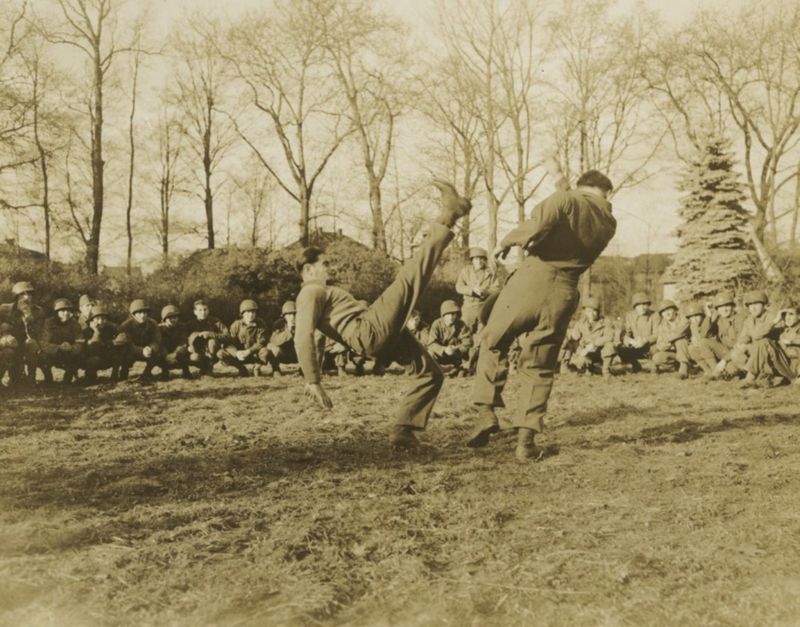
.jpg)
Left: SGT
Westerling instructs Stoottroepen
recruits in the art of unarmed
combat.
Right: SGT Bendieen explains how
British Stenguns and Brenguns work.
Note American uniforms on Dutch
recruits.
- Source: oorlogsbronnen.nl |
A scenario in which Westerling or
Bendien have handled Beynon's UD
M.'42 or were even instrumental in
the weapon staying in the
Netherlands, is not unthinkable.
|
Postwar
Beynon became an officer with the
Scranton, Pennsylvania Police
Department where he set up the
Special Weapons And Tactics (SWAT)-
team.
He passed away on
15JAN2011. |
|
(click to enlarge)
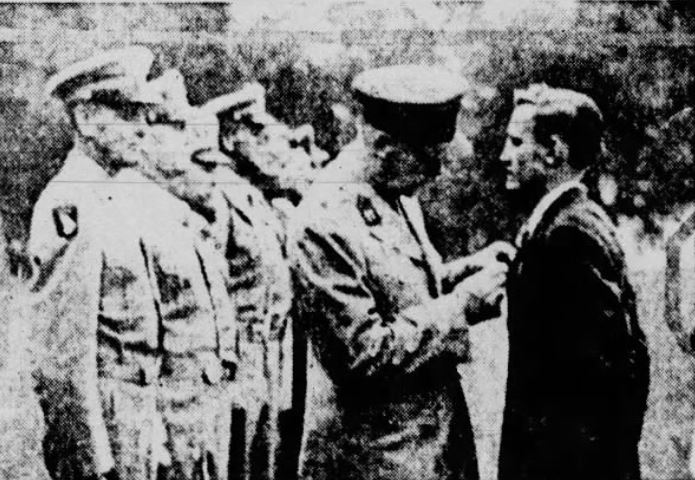
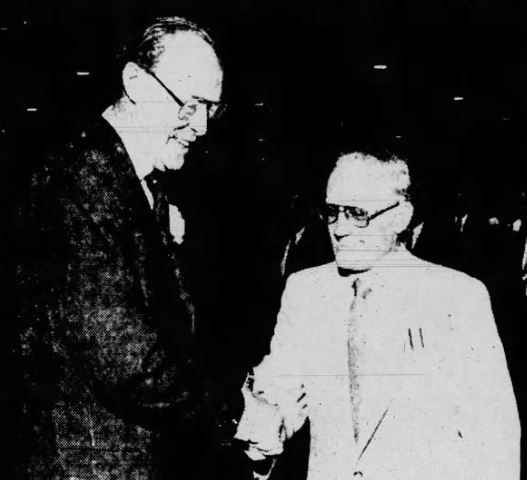
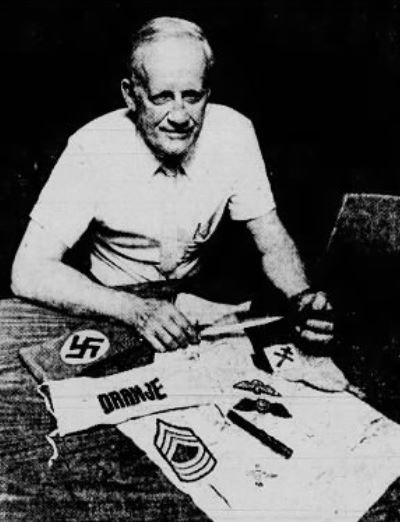
From left to
right: Beynon receiving a Dutch
award at the West Point US Military
Academy in 1947,
Beynon with Prince Bernard of the
Netherlands in Washington DC in
1982,
Beynon showing some of his war
trophies in 1985, a UD M.'42 is not
among them. |
|
Exhibits: |
|
(click to enlarge)
.jpg) 1 1 2 2.jpg) 3 3
From left to right:
1) Beynon's UD M'42 and a
second gun of the same type in the
owner's collection
2) Under the butt plate is a
small space for a maintenance kit.
Empty in this gun.
3) Beynon's UD M'42 and
several items typical for OSS agents
such as various edged weapons,
Special Forces wings patches and
4-cell magazine pouch, typical for
the UD M.'42.
 |
CONCLUSION:
It is not often that we are given
the opportunity to describe a
firearm as a Battle Relic here.
UD M.’42s submachine guns are not
only rare, but the evidence
surrounding this particular gun all
points towards an original owner who
took special part in an operation
that is one of the specialties of this
agency. This weapon that is most
likely used by a participant of
Operation “Market Garden” in an
intelligence and a clandestine
operations role, is considered a
true Battle Relic. |
|

.jpg)
Fig.: signature
from Beynon's OSS Personnel File |
UPDATE 24NOV2024:
Earlier this year a friend of this
agency contacted us regarding the
request of a relative of William
Beynon to see and hold Beynon's UD
M.42. We in turn, contacted the
owner who was willing to meet this
man, a grandson of Beynon.
This took place on
16SEP2024 in a museum in the south
of the Netherlands.
The grandson was able to tell a
family story that grandfather Beynon
had a habit of marking all his tools
with his name in capital letters.
Just as he carved "BEYNON" into his
UD M.42. He even put it in writing.
Below is a photo of the family
member holding the weapon and his
written testimony about the
autograph on it. We have
made the picture and the signature unidentifiable due
to privacy reasons: |
|
(click to enlarge)
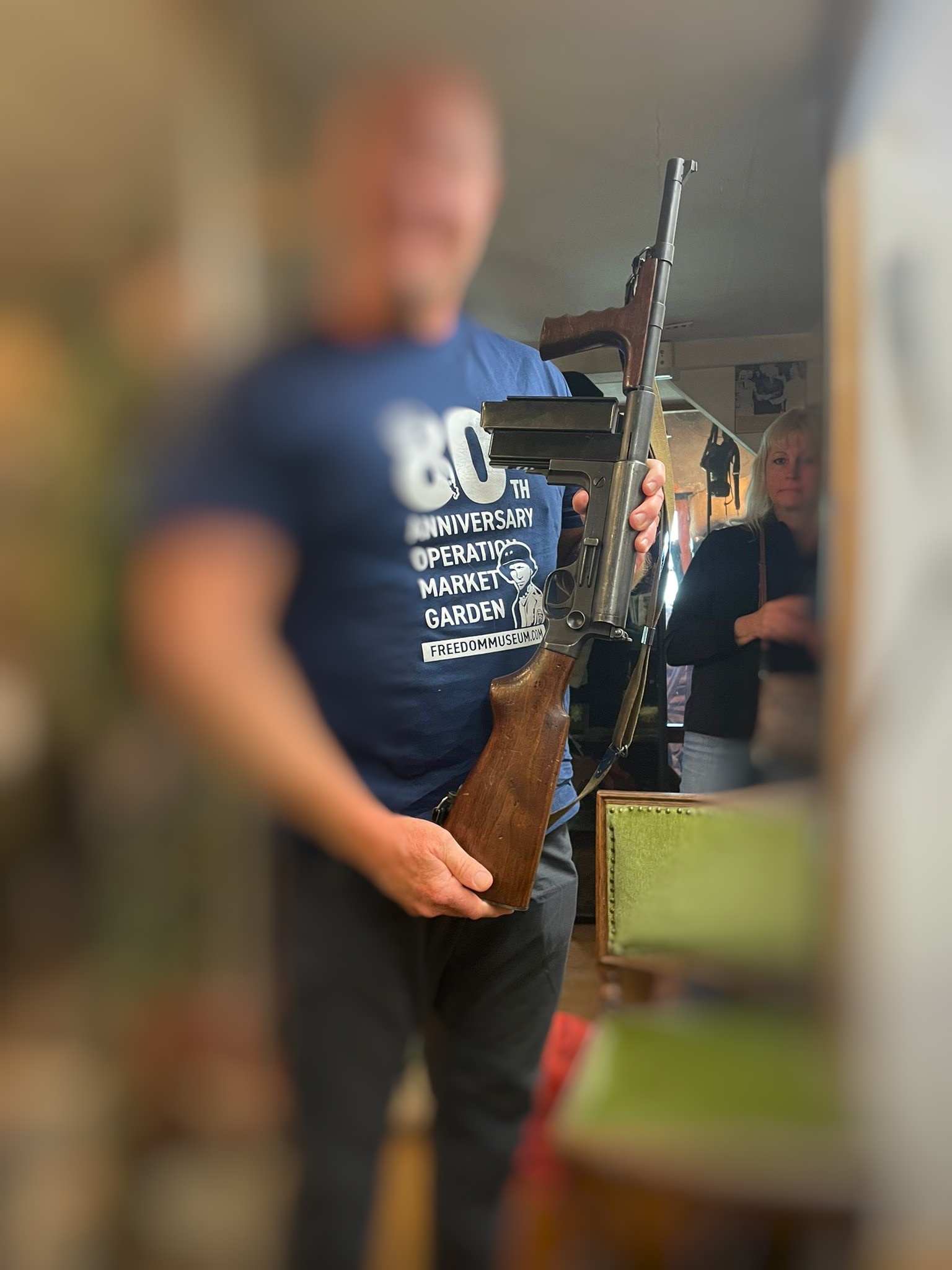
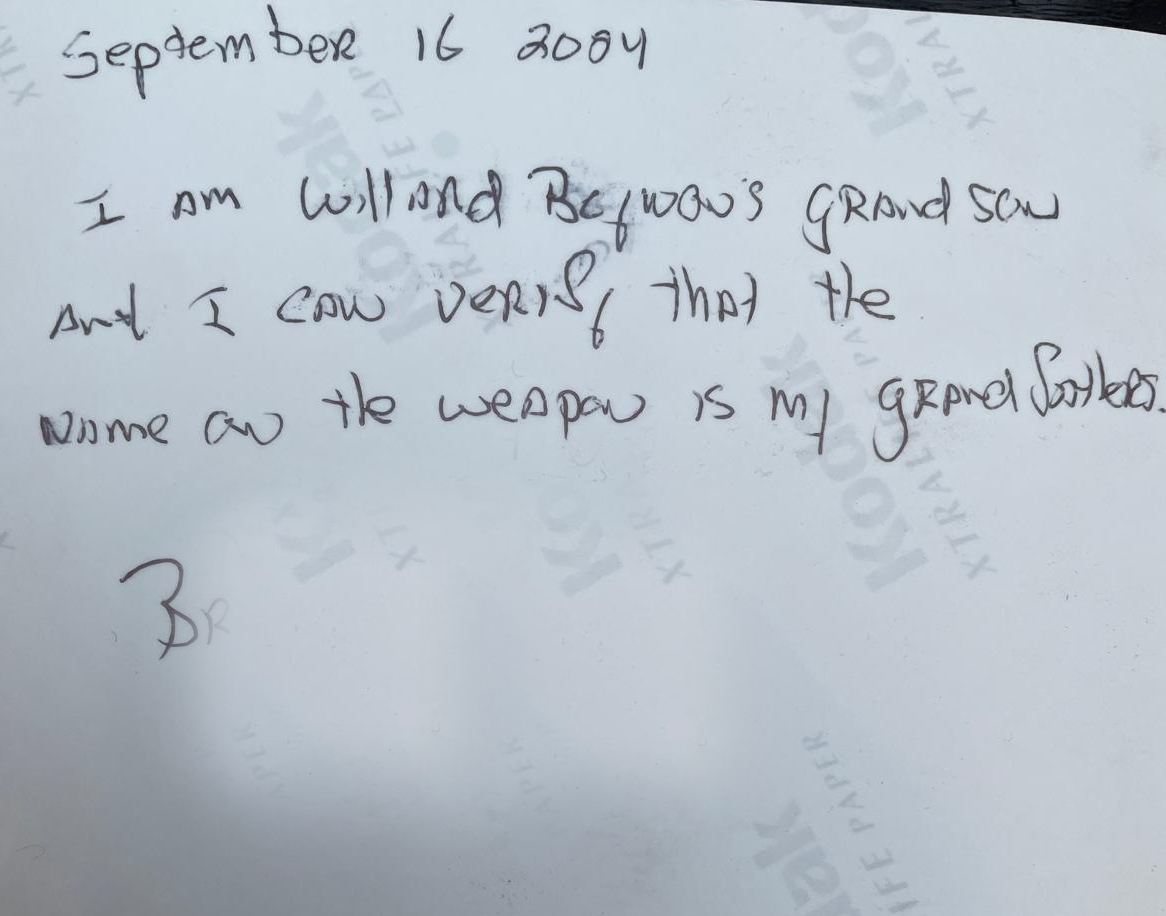 |
|
Back to Battlerelics
 |
|
|





